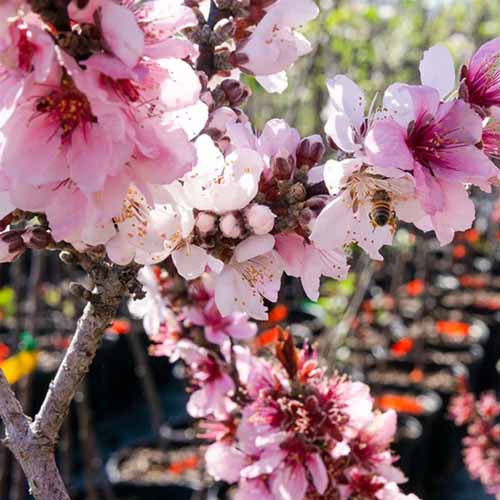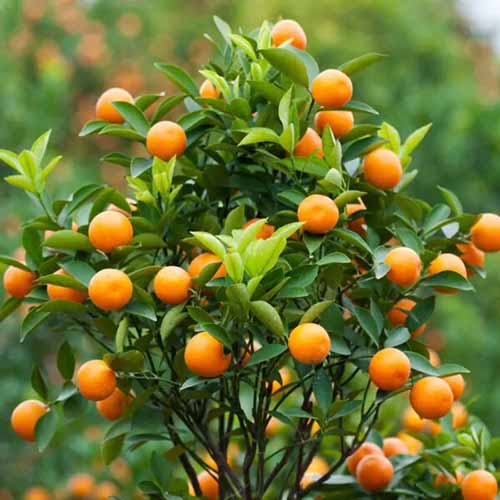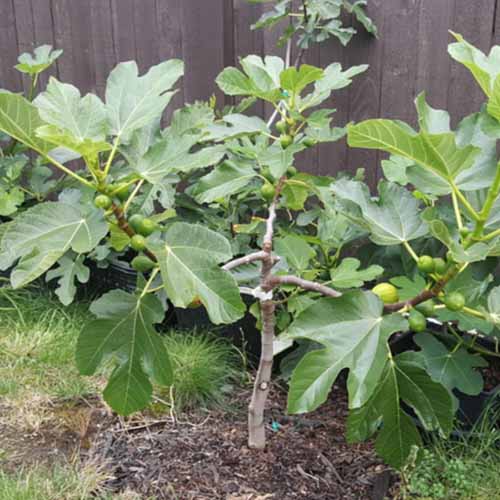As a gardener in a cold climate, I can often be found hanging out in the greenhouses of garden centers and botanical gardens in winter, wishing I could grow some of the delicious fruits I see at my own home.
Although you may not equate fruit trees with greenhouse growing – especially not at home – it’s actually possible to grow them in even a simple, unheated greenhouse.
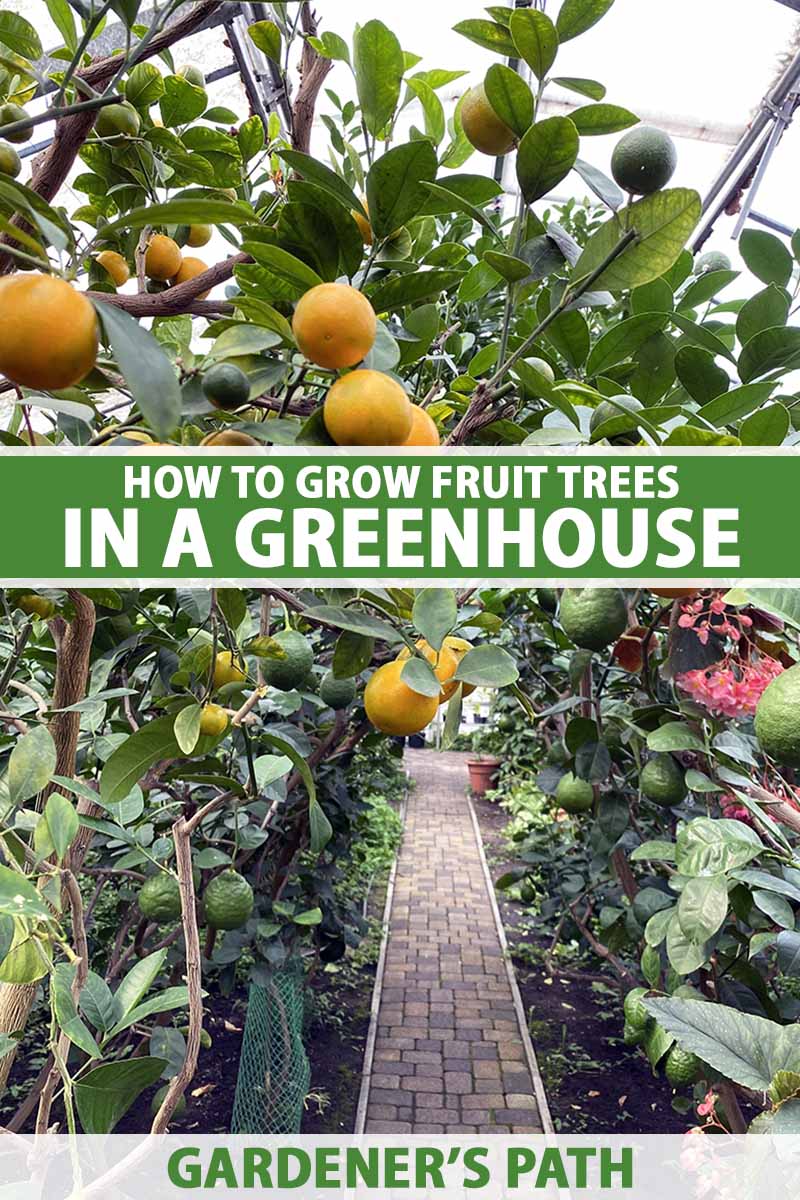
We link to vendors to help you find relevant products. If you buy from one of our links, we may earn a commission.
This guide will help you plan your project to ensure you obtain the best harvest possible.
Read on to discover what you can gain by cultivating your own fruit trees in a greenhouse, tips for planning your project, varieties to consider, and suggestions for preparing your greenhouse.
Here’s a preview of what we’ll cover:
What You’ll Learn
Why Grow Fruit in a Greenhouse?
There are a multitude of advantages to growing fruit trees in a greenhouse, and this method is becoming popular on a commercial scale as well.
Some of the benefits include:
- Earlier and longer harvest period
- Higher quality harvest
- Less chemical use (especially fungicide)
- Protection from the elements (wind, rain, frost) and animals
- Weed control
Whether your fruit tree is planted in the soil of your greenhouse or its permanent home is in a pot, you can use an outdoor structure to extend your growing season.
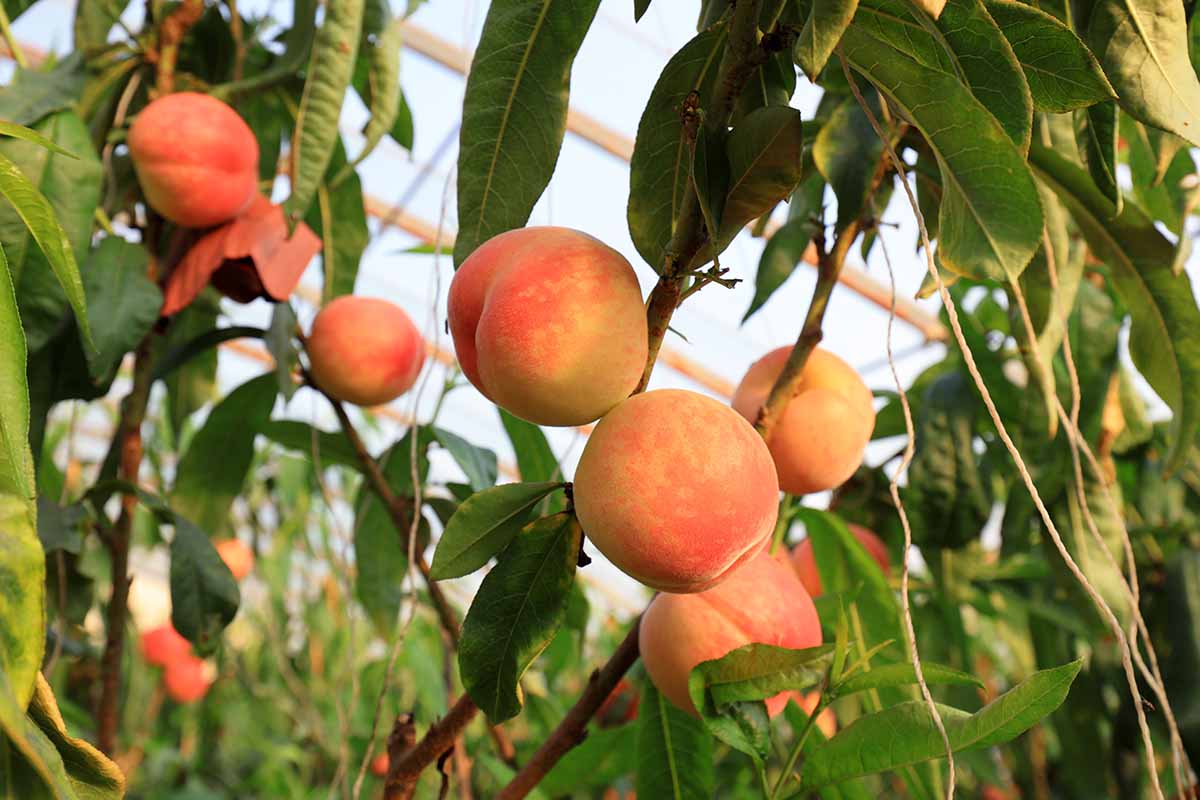
This means that you can grow types of fruit you otherwise wouldn’t be able to grow outdoors in your climate. It also allows you to grow varieties which require a longer growing season.
Many trees need a certain number of chill hours, or exposure to cold, in order to set fruit.
This is why keeping certain varieties inside your heated home during cold winters is not an option, and this is where an outdoor structure comes in handy.
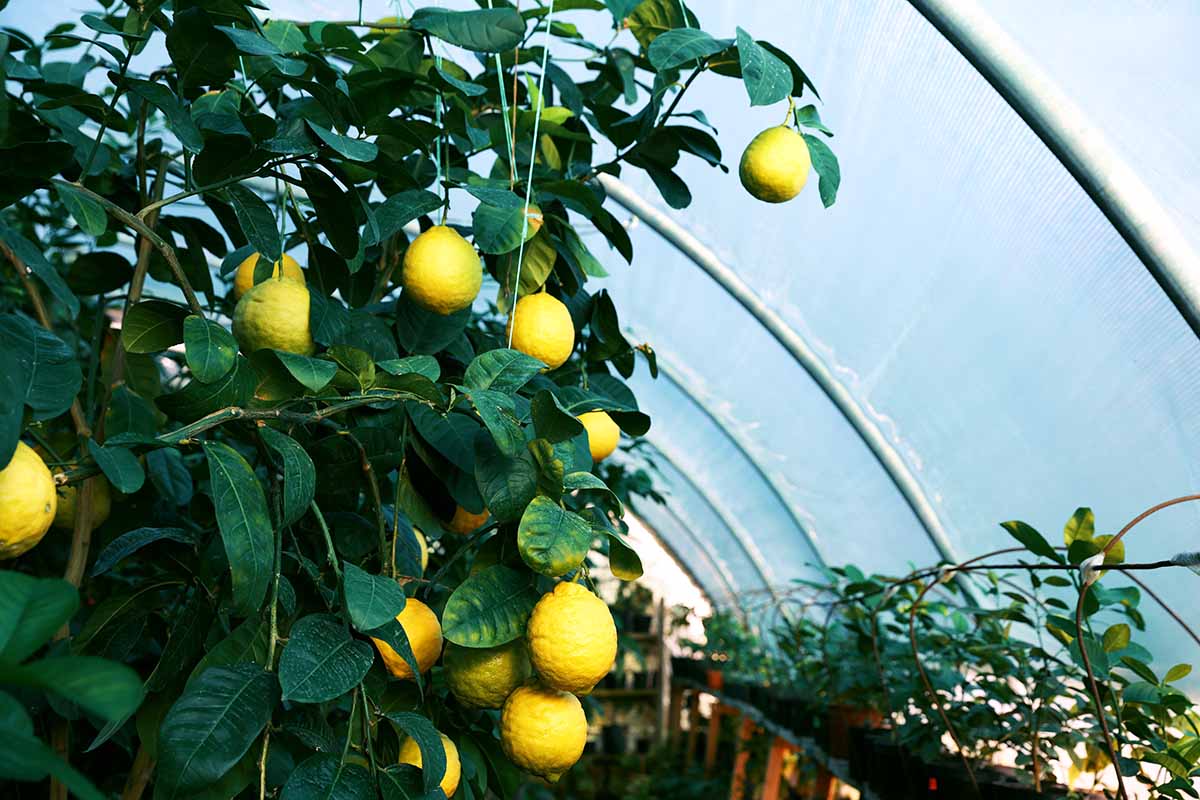
An unheated greenhouse can provide optimal temperatures for fruit trees to “chill” during the winter months.
Before You Get Started
A greenhouse can be used in a number of ways to grow fruit trees. It all comes down to your climate, what varieties you want to grow, and how you want to grow them.
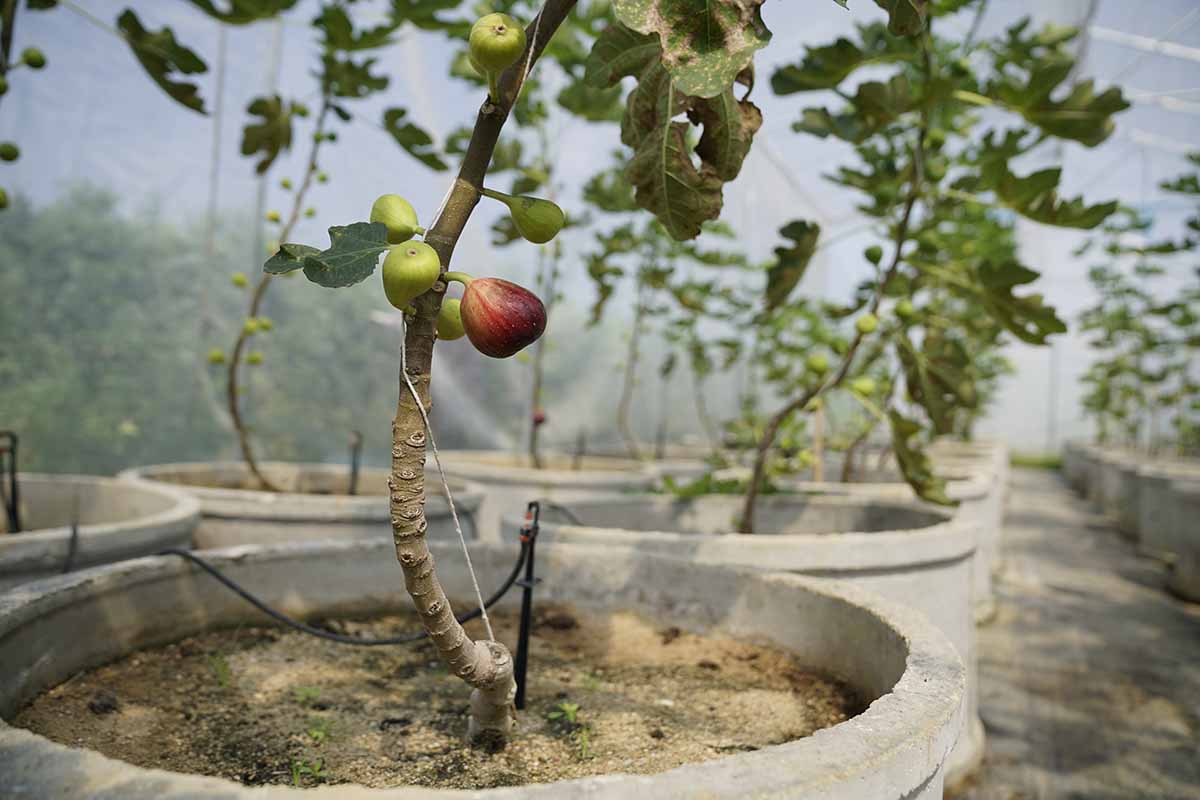
Before you get started, think about how you plan to use your greenhouse.
Are you planting directly into the soil or are you using a container to grow your fruit trees?
Are you using the greenhouse for growing your trees all year round, or are you simply moving your potted specimens into and out of the greenhouse in different seasons?
What types of fruit do you wish to grow and what are their specific needs? Is your greenhouse heated or unheated?
Unlike other plants grown in a greenhouse, fruit trees can get very big so spacing is an important consideration.
Think about how high the roof is, the spacing required between specimens, and the size of the door if you plan to move large pots in and out.
Also consider how you’ll actually move your potted specimens in and out of your greenhouse.
Many of these concerns can be addressed by selecting dwarf varieties.
Types of Fruit Trees for Greenhouses
A variety of tropical, subtropical, and temperate fruits can be grown in a greenhouse, and each of these will have their own unique requirements.
Here is a list of common fruits grown in greenhouses (to name a few!):
- Lychee
- Mandarin
- Mango
- Nectarine
- Orange
- Peach
- Persimmon
- Pomegranate
If you’re growing citrus for the first time, try a less demanding type like lemons.
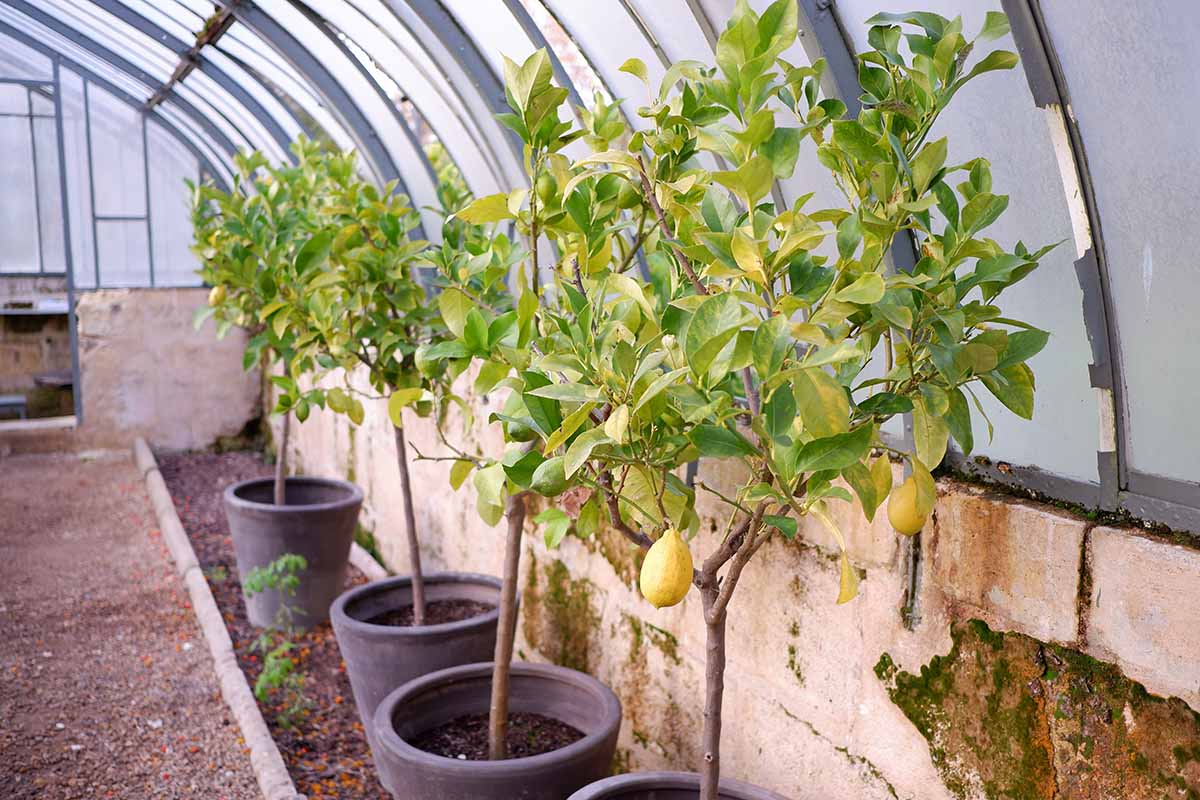
There are also a few types of limes, calamondin oranges, and kumquats which are easier to grow.
A bonus of citrus fruit is that the trees are small, evergreen, and have beautiful flowers with a heavenly aroma.
Although you can have some success keeping your citrus tree in a heated home, most do better with some chilling hours and humidity.
I can attest to this as my dear kumquat survived only one winter indoors!
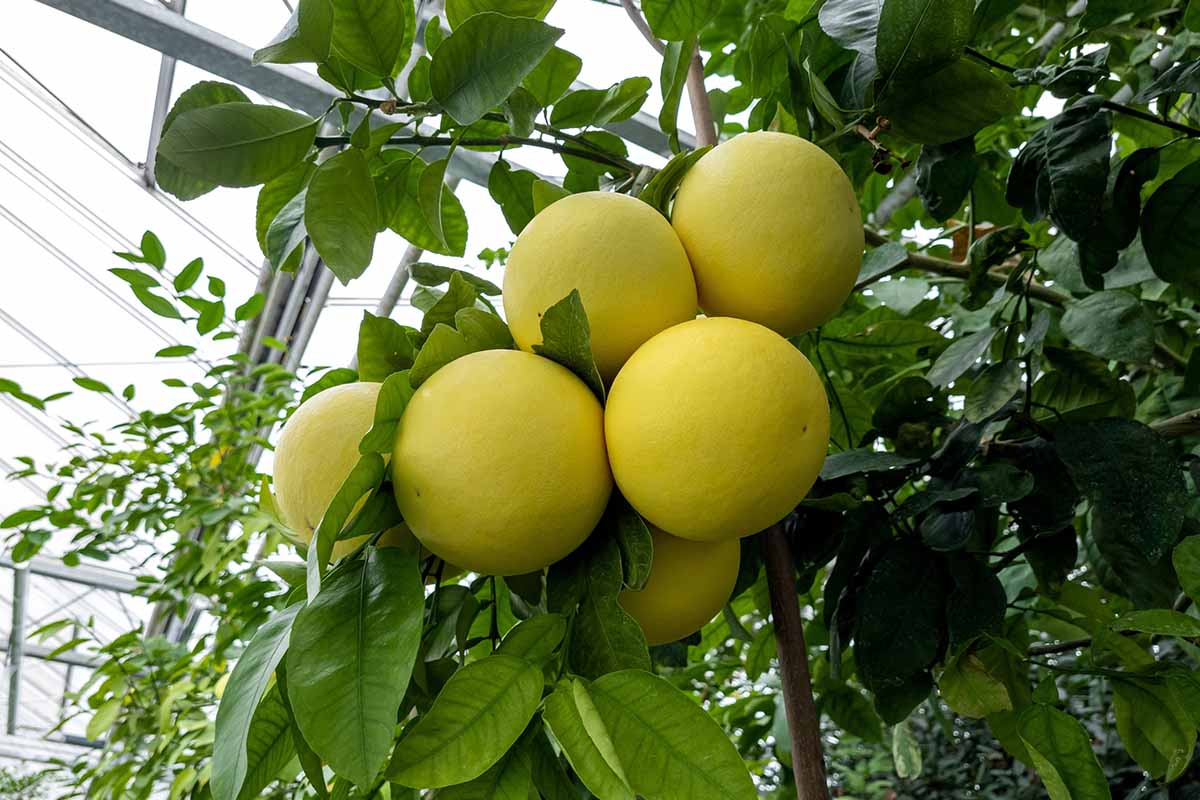
Figs are a good choice if you want to grow in containers since this arrangement suits them well. A bonus of growing figs is that you may get a double harvest during the summer.
Thinning the fruit that develops is sometimes necessary, and can be difficult if you get attached to every baby fruit like I tend to. I have to remind myself that thinning will result in a better quality harvest.
If this is too difficult for you, choose a kumquat – their fruits are so small and their growth habit is so bushy that they don’t need to be thinned.
You may be tempted to grow a number of different varieties in the same greenhouse – a peach, grapefruit, and a fig sound nice!
However, you need to choose those that have the same or very similar needs since your greenhouse will have one climate only.
Cultivars to Select
Ready to choose your varieties? As I mentioned before, this will be a big part of your project planning, so you want to give it some serious thought.
Here are some recommended varieties to check out:
Known for its superior taste, the ‘Meyer Improved’ lemon will appeal to gardeners and chefs alike.
Pruning this lemon will keep it small – otherwise it can reach between eight to 15 feet in height.
It’s available at Nature Hills Nursery in #1 and #3 containers.
Not only is the ‘Bonfire’ patio peach a great choice for containers, it also displays attractive burgundy foliage in autumn.
Its mature height and width is only four to six feet and you can find one in a five-gallon pot available at Perfect Plants.
For a specimen that is sure to attract your gaze and palate, choose the dwarf ‘Brown Select’ satsuma.
The satsumas are incredibly juicy and so easy to peel, making them a sought-after variety when they show up at the grocery store.
This tree doesn’t need to be pruned and will grow six to 10 feet tall at most.
You can guarantee your very own harvest with a tree from Nature Hills Nursery.
If you’re looking for something low maintenance, look no further than the ‘Miss Figgy’ fig, available in three-gallon containers from Planting Tree.
This little fig doesn’t require pruning and is ideal for containers.
Finally, the ‘Dwarf Cavendish’ banana is a popular variety that won’t grow taller than eight feet.
But don’t be fooled by its size, this petite specimen can produce a harvest of 90 bananas at maturity!
You can order yours from Nature Hills Nursery. Two- to three-feet-tall plants are available in #1 containers.
Pollination
Growing fruit trees in an enclosed structure reminds us of the important job of pollinating insects – a job we may have to do ourselves in the greenhouse!
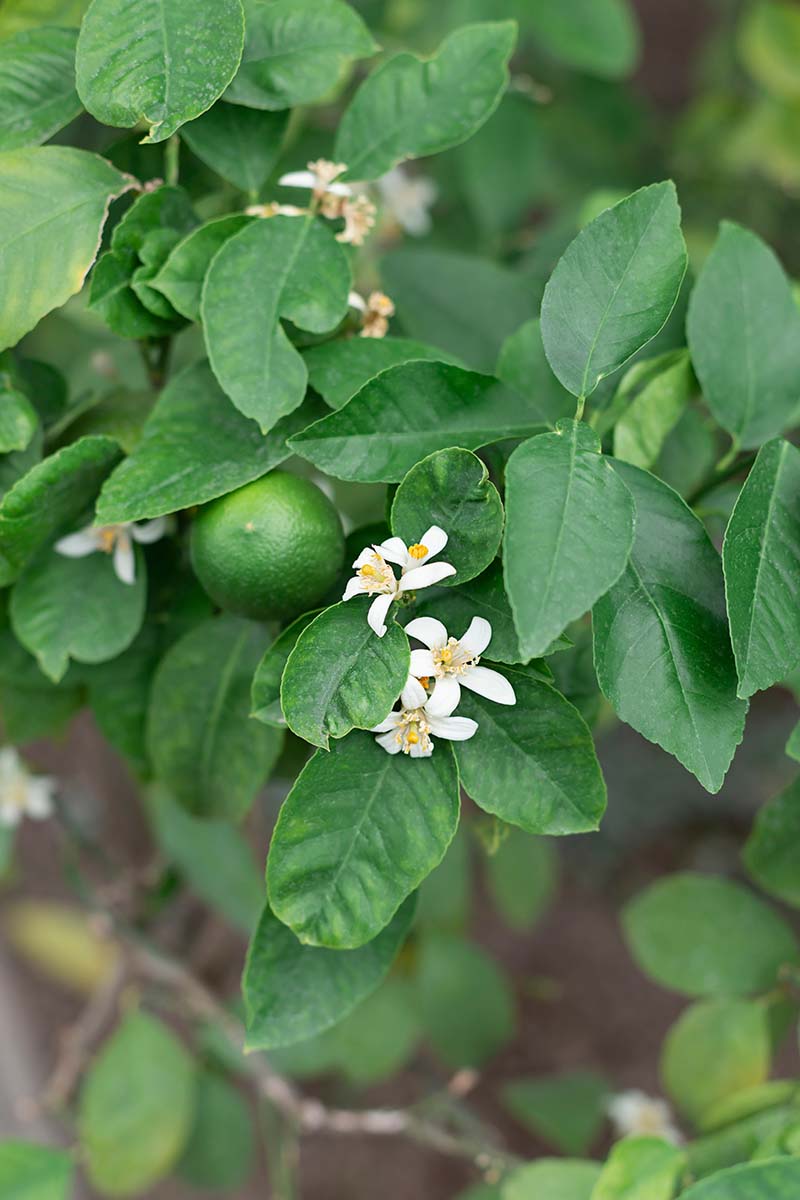
If the variety you choose to grow is self-infertile and needs another variety to achieve pollination, you’ll need to take over the bee’s job and transfer pollen between flowers with a paintbrush or other utensil.
This should be done each morning during the flowering period to ensure success.
It’s a pretty fun task though, and when the fruit finally starts to develop, it’s a wonderful feeling! If you want to avoid this extra step, choose a self-fertile variety.
Greenhouse Setup
Controlling the environment in your greenhouse may or may not require a lot of extra work and gadgets – it’s largely up to you.
However you choose to do it, there are some factors which need to be controlled in order to successfully grow fruit trees in a greenhouse:
Light
You may already know that greenhouse materials prevent some sunlight from reaching the plants inside, sometimes providing only 60 to 70 percent of the sunlight that outdoor-grown plants would receive.
But did you know that sunlight distribution will also vary in different parts of the greenhouse?

The middle and southern areas will receive significantly more light than the northern section. This is important to consider especially if planting fruit trees into a permanent location.
To increase light in your structure, use reflective films on the floor and higher transparency film on the outside walls.
Maintaining a squeaky-clean greenhouse will pay off too since it will maximize the sunlight shining through.
Humidity
There’s an ideal range of humidity for your fruit trees, which will depend on the season and the varieties you’re growing.
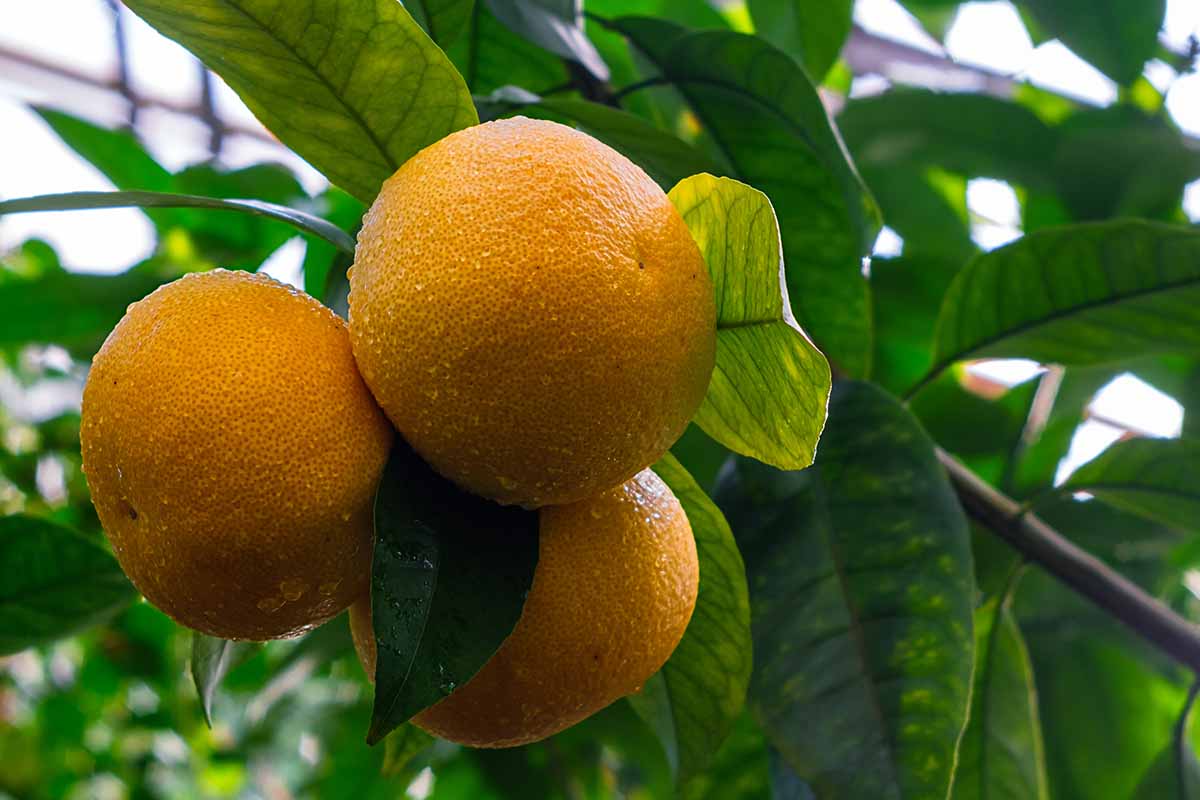
For example, fruit trees have differing requirements before and after flowering.
Apricots, for instance, need more humidity (60 to 80 percent) before flowering, and less humidity after flowering (no more than 60 percent).
Retractable films or other structures that you can open and close can help you regulate humidity and temperature in your structure.
While humidity is important, proper ventilation is equally important as it will prevent diseases from developing.
Temperature
You’ll need to monitor and regulate the temperature, so it doesn’t swing too far in either direction.
While the spring sun may warm your face just enough, it can easily bring your greenhouse above 95°F (35°C) and overheat your fruit trees.
This is especially damaging to the plants during the time of blooming and fruit development and can prevent the tree from fruiting.
But even a few weeks before blooming, high temperatures can make the plant focus its energy on leafy growth which will also prevent you from getting the harvest you desire.
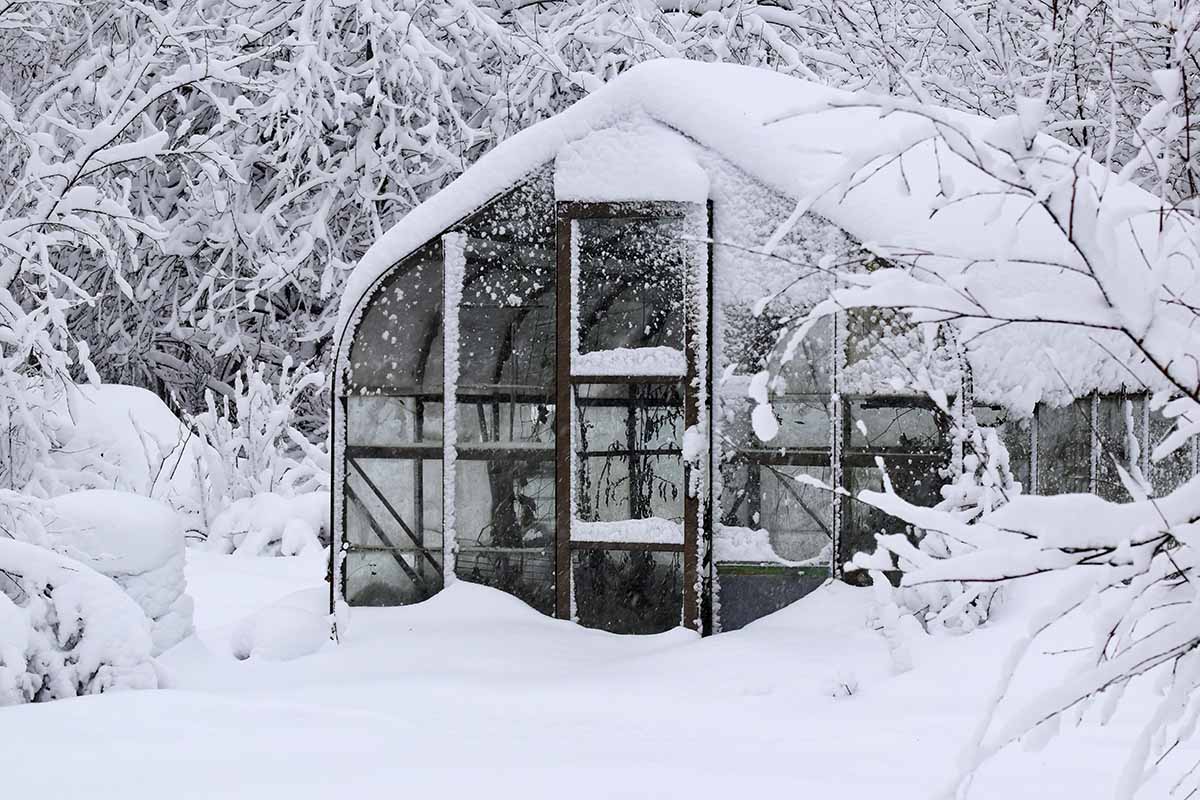
Your plants will not appreciate it being too cold either, and this will vary depending on the type of fruit and even the variety.
Here are the lowest temperatures acceptable for some types of citrus, but it’s best to check your specific variety as well:
- Lemons – 42°F (5°C)
- Kumquats – 45°F (7°C)
- Limes – 50°F (10°C)
- Grapefruit – 50°F (10°C)
- Calamondin oranges – 55°F (13°C)
Remember, the floor will be colder at night than whatever the reading on your thermometer shows.
Try covering the floor with black or white plastic mulch to increase the temperature.
If your fruit tree is in a pot, you can warm it up with straw bales, burlap, or other breathable insulating materials.
Peaches and Cream, with a Few Challenges
As you can see, growing fruit in a greenhouse is not all peaches and cream – there may be challenges to overcome.
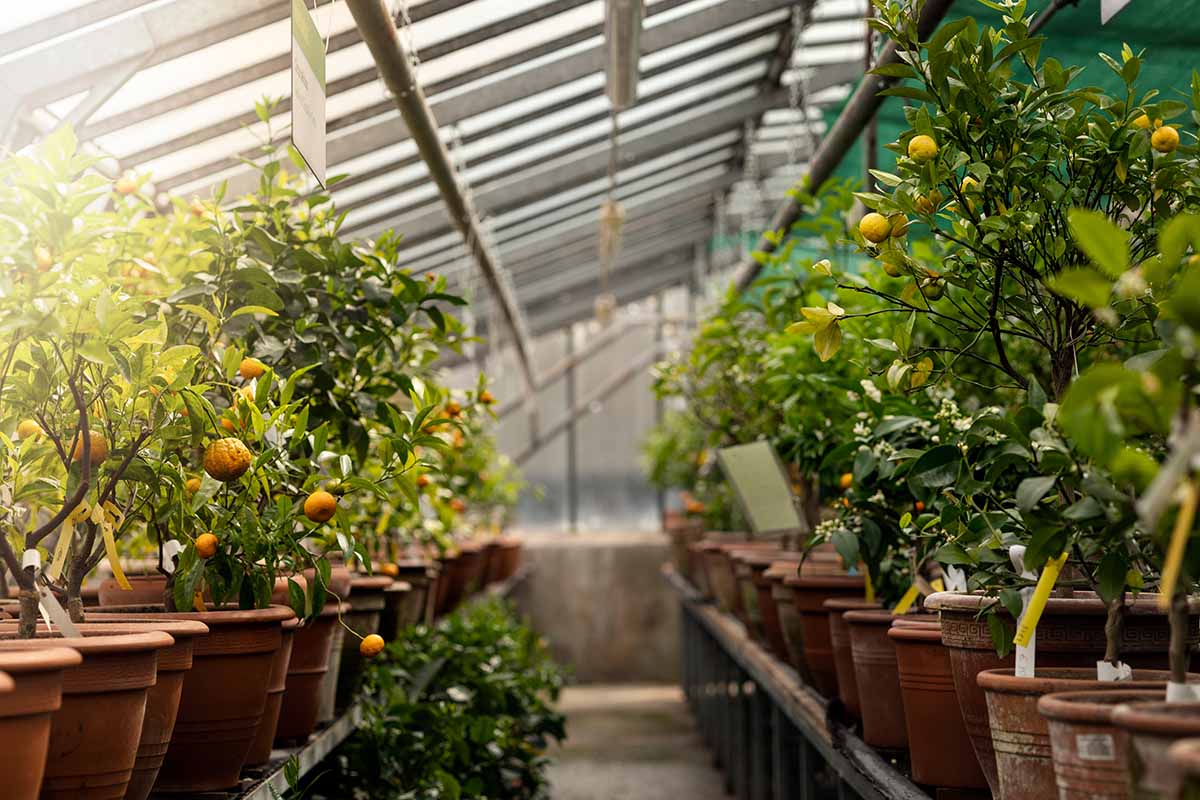
But a this method can open the door to the possibility of growing a number of different types of fruit in your own backyard.
It can also improve your harvest and get it to you sooner and over a longer period of time. For passionate gardeners like myself, that’s a pretty sweet deal.
So if you own a greenhouse or are planning to build one, why not try growing a fruit tree inside?
If you already have experience growing fruit in your greenhouse, please share your successes and challenges in the comments section below.
If you want to learn more about growing plants in a greenhouse, take a look at these guides next:

